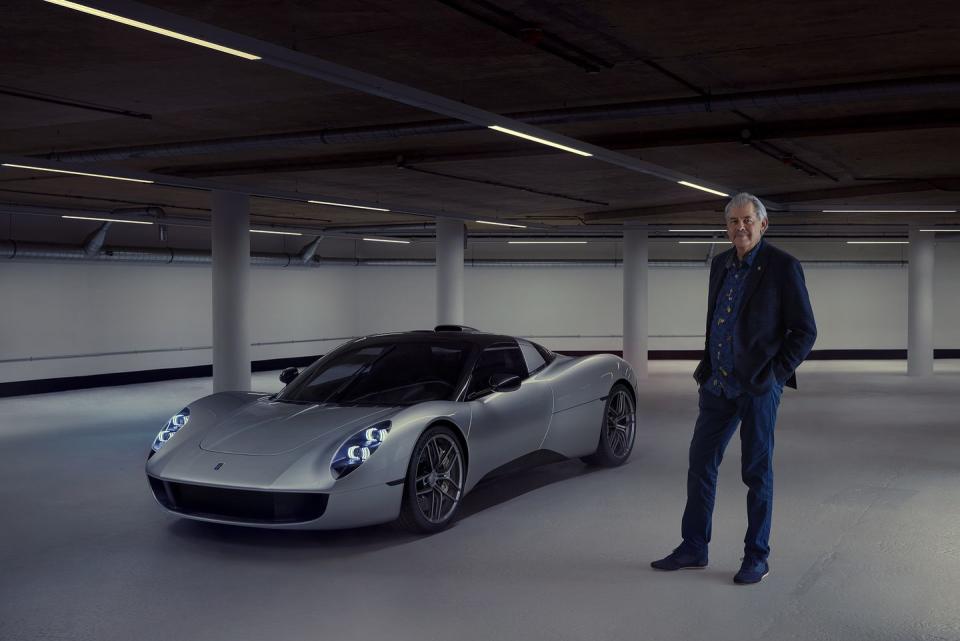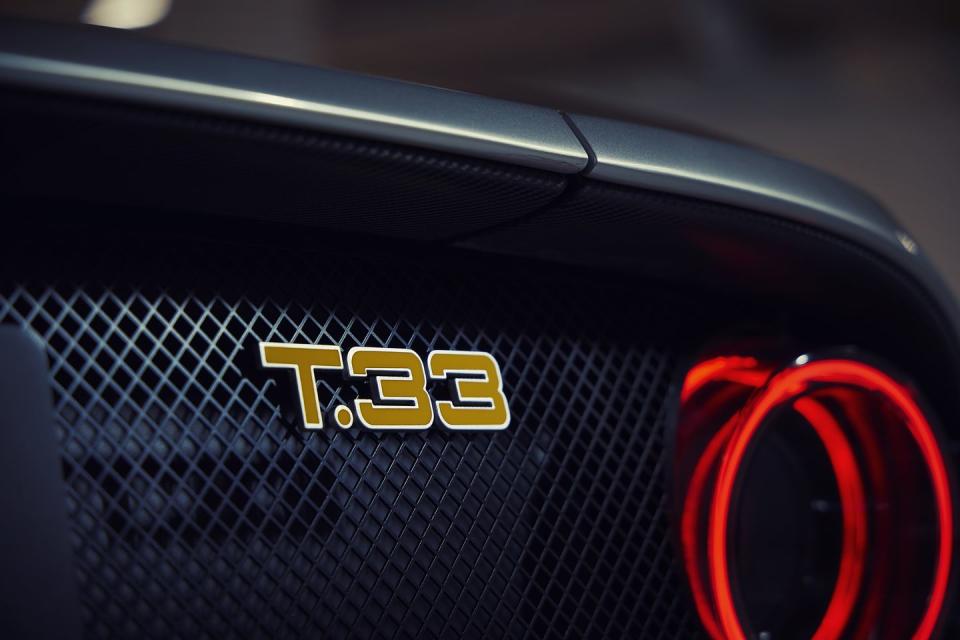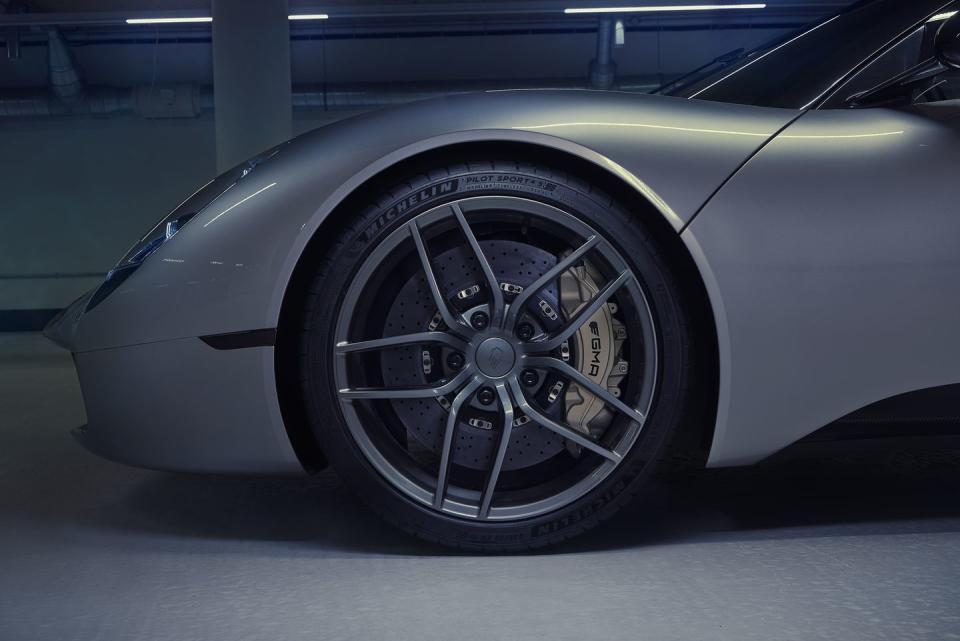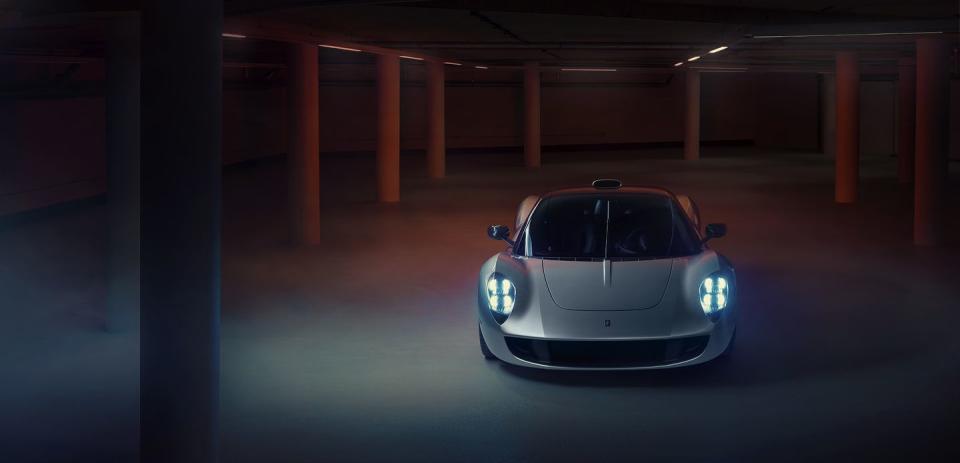Gordon Murray’s Next Supercar Packs a 607-HP V-12 and a Manual


Gordon Murray Automotive first came on the scene with the T.50, Murray’s vision for a current-day McLaren F1 successor. But that’s not the only car he’ll make. Murray’s company has a product roadmap stretching to 2033, and the vehicle you see here is next on the list: The GMA T.33. Like the T.50, it’s a mid-engine supercar, powered by a naturally-aspirated V-12 paired to a manual transmission. It weighs 2400 pounds, makes 607 hp, and costs around $1.85 million.
That makes it, so far, the more affordable of GMA’s two vehicles, positioned beneath the $3 million T.50. Murray told his customers that the T.50 would be unique, even among the highly specialized vehicles this company aims to release—no other GMA would be so lightweight, none would rev so high, and most notably, none would feature the T.50’s distinctive three-seat, center-driver layout. So the T.33 is a conventional two-seater, which allowed Murray to give his newest car evocative proportions.

“I grew up watching sports-racing cars in the Sixties,” Murray tells Road & Track. “And for me, the Italian cars were absolutely it as far as proportion goes. And not just proportions, but the actual classic shapes and curves.” Murray names some of his favorites: The Ferrari Dino 206 SP, P2 and P3; the Alfa Romeo Tipo 33 Stradale and Giulietta TZ1; the Abarth 1000 and 2000 SP. “I’ve always wanted to do a car with those proportions and use all those influences, but in a bang-up-to-date shape.”
The T.33 uses a version of the Cosworth 4.0-liter V-12 engine that powers the T.50. Here dubbed GMA.2, it carries modified heads, new cams, new intake and exhaust, and reworked valve timing. The aim was to make the engine better suited for daily use, with a nice broad torque curve and a lower redline. These things are relative, of course—that “lower” redline is now 11,100 rpm; the GMA.2 has a 14:1 compression ratio, makes 607 hp at 10,500 rpm and 333 lb-ft of torque at 9000 rpm, and delivers 75 percent of its peak torque as low as 2500 rpm and at least 90 percent from 4500 to 10,500. It’s still a clean-sheet, naturally aspirated Cosworth V-12, after all.
Murray is especially proud of the intake design. “I’ve always wanted to do a road car where the airbox is attached directly to the engine and moves independently of the body,” he says. On the T.33, the air intake pokes through the glass engine cover, similar to the track-only GMA T.50S. “When I told [Cosworth] 33 needed to have an airbox like that, there was a lot of silence, pregnant pauses and sucking of teeth,” Murray says, admitting that the request was, in his word, “wacky.” The four throttle bodies sit inside the ram-air box, feeding a separate plenum for each cylinder bank, a setup Murray credits for the GMA.2’s impressive torque curve.
The transverse Xtrac six-speed manual transaxle uses the same casing found in the T.50, with different internals and unique ratios. Unlike the T.50, this model will offer the option of a paddle-shift six-speed sequential automatic, similar to a unit Xtrac builds for touring car racing. Murray claims this transmission offers the world’s fastest gear-change.
“There’s no torque interruption at all,” he says. “Other people talk about 10 milliseconds, 15 milliseconds, three milliseconds. This has zero milliseconds. It’s a completely seamless shift. It’s a pre-selector, so you are already in the next gear.” Still, most buyers have chosen the conventional manual—Murray says over half of the T.33’s 100-car production run is already spoken for, and just three customers have chosen the paddle-shift gearbox so far.

The T.33’s chassis is entirely unique, built according to Murray’s “iStream Superlight” principles. An aluminum tube-frame spans nearly the full length of the car, with bonded carbon-fiber panels making up the passenger compartment and engine bay. Most carbon-fiber supercars use a central carbon monocoque with aluminum or steel front and rear subframes bolted on. “The problem with that is … every time you bolt something, it’s quite complicated and heavy, and it is flexible,” Murray says. In the T.33, the continuous aluminum tube frame has no joints, eliminating this potential for flex, and the bonded carbon fiber adds strength and rigidity where it’s needed.
This chassis, with its metal-and-carbon-fiber construction, ends up about 200 pounds heavier than the T.50’s full-carbon-fiber monocoque, but it will form the basis of multiple future GMA models, including hybrids and EVs. And the T.33 is still an incredibly lightweight vehicle at 2400 pounds—less than a McLaren F1, and as Murray points out, with a power-to-weight ratio that approaches the LaFerrari.

The suspension design is pure and simple sports car: Double wishbones all around, the rears mounted directly to the transmission casing, with coilover springs and passive dampers. There are no electronic suspension modes, no adaptive valving, not even an anti-roll bar at the rear. As he did with the T.50, Murray took inspiration from his daily driver, a new-generation Alpine A110, a vehicle he says strikes the balance between handling and ride comfort better than anything currently on the market. (Murray loves using mass-production sports cars for his ride-and-handling benchmarks: He took inspiration from the first-generation Acura NSX while developing the McLaren F1.) The GMA team took apart Murray’s A110 to see if Alpine had used any chassis or suspension tricks to achieve this delicate balance. They found none.
“It just goes to show my theory, that if you build a car stiff enough and light enough, you don’t need any hydropneumatic roll control or active damping,” Murray says. “That all happens when you build a 1500 to 2000 kg car, and suddenly you’ve got a tank on your hands and you need to make it feel good.”

The T.33 uses a unique wheel design, but otherwise, the four corners of the chassis are almost identical to what you’d find on the T.50: Carbon-ceramic brakes, with 370-mm rotors and six-piston calipers up front, 340 mm and four pistons in the rear. The T.33 rides on mainstream Michelin Pilot 4S tires measuring 235/35R-19 in front and 295/35R-20 out back. Murray wanted the T.33’s service costs to be reasonable, unlike the notoriously expensive-to-own McLaren F1, hence the off-the-shelf tires.
GMA is still developing an all-new hydraulic power steering system for the T.33. The T.50 uses a fully manual steering rack, with an electric assist motor that engages at low speeds. The system provides excellent feel and feedback, but it’s fearsomely expensive, and would have been prohibitive in the more affordable (relatively speaking) model. “We want to develop really lovely hydraulic steering that everybody loves, hopefully that we can take forward with all future models,” Murray says.
The biggest change from T.50 to T.33 is at the rear. The T.50 uses a zany aerodynamic setup with an electric fan sticking out of the rear bodywork that can generate downforce or reduce drag depending on drive mode. The T.33 uses a much simpler setup. There’s a deployable spoiler at the rear, but around two-thirds of the car’s downforce is generated by large diffusers behind the front wheels, which allowed GMA to avoid adding ungainly splitters or dive planes. The design came about almost by accident: While experimenting with virtual setups for the T.50’s fan-based aero system, a GMA engineer came up with a design that generated downforce even when the fan was switched off. That layout was adapted for the T.33.
The new car’s cockpit resembles the T.50’s, though very few parts are carried over. The driver faces a simple gauge cluster, a floodlit analog tachometer in the center flanked by screens for vehicle information and Apple Carplay or Android Auto. “No expense spared on materials and feel and switch haptics and all that sort of stuff,” Murray says.
GMA envisions the T.33 as an everyday supercar. The front and rear trunks add up to nearly 10 cubic feet of cargo space, more than a current Porsche 718 Boxster. Unlike the T.50, which is tailored to the owner at the factory, the T.33’s seat, steering wheel, and pedals are adjustable. And not only will the T.33 be available in left- and right-hand drive, Murray says it will be federalized and fully street-legal in the U.S.
Murray insists that, despite the huge power and low weight, the T.33 is not just a numbers car. “It’s got absolute focus on the driver experience,” he says. “The thing is going to be quick, but we’re not chasing zero-to-60s, or Norschleife times, or top speed, or horsepower.”

Naturally, given the price and exclusivity, most customers who have reserved a T.33 already own quite a collection of exotic cars. Many of them own Porsche Carrera GTs, which offers a handy comparison for Murray, who describes the T.33 as “a more usable Carrera GT, but on steroids.” Both are lightweight, manual-transmission supercars with high-revving naturally aspirated engines making more than 600 hp. But the T.33 is around 600 pounds lighter, with traction and stability control, copious luggage space, and better ground clearance.
The T.33 is priced at £1.37 million before taxes, which is about $1.85 million at today's exchange rates. No doubt, that’s an awful lot of money—though it’s nearly $800,000 less than a T.50, and around $150,000 less than the 200-mile Carrera GT that just sold on Bring a Trailer.
What’s most important, though, is that the T.33 gives GMA the building blocks to create a number of future models. With bones like these, they’re bound to be exciting.
You Might Also Like

 Yahoo Movies
Yahoo Movies 
